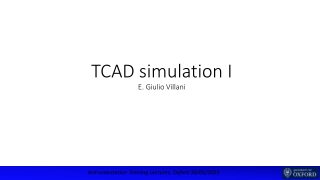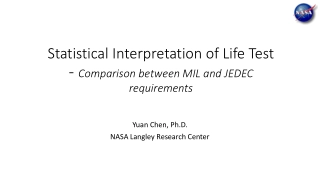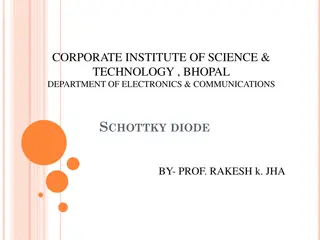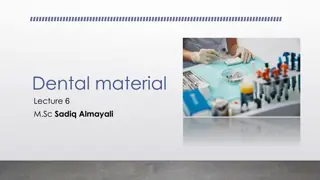Overview of Semiconductor Materials and Applications
Understanding electronic transport in semiconductors is essential for various applications such as computers, smartphones, LEDs, and more. Semiconductors like silicon and compound semiconductors play a crucial role in creating devices with unique properties. By delving into the world of semiconducting materials, one can explore intrinsic and compound semiconductors, their electrical conductivity compared to metals and insulators, and the role of energy bands in determining the conductivity of semiconductors. The wide range of semiconductor applications showcases their versatility in modern technology.
Download Presentation

Please find below an Image/Link to download the presentation.
The content on the website is provided AS IS for your information and personal use only. It may not be sold, licensed, or shared on other websites without obtaining consent from the author. Download presentation by click this link. If you encounter any issues during the download, it is possible that the publisher has removed the file from their server.
E N D
Presentation Transcript
Electronic Transport in Electronic Transport in Semiconductors Semiconductors Dr. Girish Chandra Tewari Department of Chemistry and Material Science Aalto University 2-11-2020
Semiconductors Semiconductor applications: Computers, laptops Silicon (Si) MOSFETs, ICs, CMOS Smart phones, Cell Phones, pagers Si ICs, GaAs FETs, BJTs Storage devices (USB,CD players) AlGaAs and InGaP laser diodes, Si photodiodes TV remotes, mobile terminals diodes (LEDs) Satellite dishes InGaAs MMICs (Monolithic MicrowaveICs) Fiber networks InGaAsP laser diodes, pin photodiodes Traffic signals, car GaN LEDs (green, blue) taillights InGaAsP LEDs (red, amber) Air bags Si MEMs, Si ICs The Wide choice to alter the physical properties (example: high to low electrical resistivity, optical materials covering from UV to far infrared applications) Light emitting Ultra-fast response times Multi-functional devices (source, operation and detection) Tailoring opportunity, in such a way that the device allows to implement all sorts of information processing Boolean logics, signal amplifiers, store and retrieve information, processing, light source many more
Semiconducting Materials Semiconducting Materials Intrinsic semiconductors Si and Ge (column IV of periodic table) Compound semiconductors Binary combinations of atoms of column III and column V and some atoms from column II and VI. Ternary (three elements) compounds (GaAsP) Quaternary (four elements) InGaAsP
Introduction Electrical conductivity lie between Conductors (Metals) and Insulators. Ex : Silicon and Germanium Difference in conductivity Band Gap (0eV < Eg <4 eV) Metal Semiconductor Insulator Silver, platinum, copper gold.. etc Silicon, Germanium, etc., Teflon, Quartz, SiO2 etc., Conductivity : 106to 1 ( -m)-110-8 to 103 10-7- 10-25 Highest occupied energy bands are partially filled with electrons: Valance Band Completely filled at low temperatures. Conduction band is empty
Metals Insulators Semiconductors Highest occupied energy bands are partially filled with electrons, while above the Fermi energy level(EF) all bands are empty. With a very small amount of energy lead the electrons go to the conduction band, leading to high conductivity. At T>0 electrons thermally excited and cross the barrier of EF At T=0 Conduction band is completely empty and valence band is filled, leading to zero conductivity. Very big energy gap (Eg>4.5 eV)between conduction (EC) and Valance (EV) bands, where EFis in the middle. No thermal excitation and hence even higher temperature, conduction is zero At T=0, conduction band is empty, and valence band is filled, hence zero conductivity. Egis < 4eV( Si: 1.17, Ge=0.74, GaAs= 1.52eV at T=0). At higher temperature electron thermal excitation does happen and hence the conductivity lies between metal and insulator
Type of Semicondutors (1) Intrinsic (Undoped): Pure semiconductors are referred as intrinsic semiconductors They consist almost equal number of holes and electrons which are generated by themal excitation at finite temperature Zero Kelvin they behave like insulators (2)Extrintrinsic (Doped): Addition of impurities in controlled amounts would take semiconductor performance into new dimensions Adding a small amount of electrons (or holes) would dramatically change the transport properties of intrinsic semiconductor Effect of doping (addition of either electron acceptors or electron donors) will increase the densities of respective carriers and hence the change in the conductivity Depending on the dopant, electrons or holes, the semiconductor may be an N-type or P-type.
N-type dopant P-type dopant Called Donors Called Acceptors pure silicon Group V impurities (e.g. Antimony, Phosphorous, Arsenic etc., ) Group III impurities (e.g. Boron, Gallium and Indium) Possess five valence electrons Possess three valence electrons Each atom covalently tries to bond with five lattice atoms Each atom covalently bonds with 3 host atoms N-type doping Leaves an excess electron for every impurity atom in group IV matrix Leaves unmade bond constitutes an excess hole for every impurity atom in group IV matrix When doped with the semiconductors then the semiconductor is known as n- TYPE semiconductor When doped with the semiconductors then the semiconductor is known as p- TYPE semiconductor P-type doping Electrons dominate the conduction process (majority carriers) Holes dominate conduction process (majority carriers)
(A) n-type and (B) p type doped semiconductor N-type: The impurity atom is strongly bonded into the crystalline structure Additional electron is loosely bounded, and therefore it behaves more like a free-electron In the band diagram, the energy levels of these donor atoms lie in the forbidden gap, slightly below the conduction band of intrinsic semiconductor. Donor energy levels (E d ) in eV As= 0.054 ; P= 0.045 Sb= 0.043 Acceptor energy levels (E a) in eV Al= 0.072 ; B= 0.045 Ga= 0.074 ; In=0.157 P-type: The dopant is ready to accept one electron and thus called an Acceptor The Acceptor energy level are close to valence band
Temperature (T) Dependence of Resistivity () of Semiconductor The concentration of intrinsic carriers i.e. the number of electrons in conduction band per unit volume is given by the expression 3 2 ????? 2? 2 ? = 2 exp(? ??)/??? and the concentration of holes in valence band is given by the expressions 3 2 ? ??? 2? 2 ? = 2 exp ? /??? Multiplication of above expressions 3 ??? 2? 2 3 2exp( ??/???) ?? = 4 ??? This does not involve the Fermi level (?) and is known as the expression of law of mass action. Where ??= Effective mass of an electron ? = Effective mass of a hole, ?? = Boltzamann's constant, ??= Bandgap, ? = Temperature in K
In case of intrinsic (highly purified) crystals, the number of electrons is equal to the number of holes, because the thermal excitation of an electron leave behind a hole in the valence band. 3 2 ??? 2? 2 3 4exp( ??/2???) ? = ? = 2 (??? ) Thus, we see that the concentration of intrinsic carrier depend exponentially on ??/2???. CONDUCTIVITY OF INTRINSIC SEMICONDUCTOR The electrical conductivity will be the sum of the contributions of both electrons and holes ? = (????+ ??? ) Where ? is the electron charge. ??and ? are the average velocities acquired by the electrons and holes in a unit electric field and known as mobilities. ? = ??(??+ ? ) if ? = ? 3 2 ??+ ? exp( ??/2???) ? = ?? Finally where K is constant 3 2 ??+ ? ) 1?= ???(??/2???)/(?? Resistivity =
3 2 and the mobilities change relatively slow with ? compared with the exponential term, and hence the The factor ? logarithm of resistivity (=1/ ) varies linearly with 1/?. The energy gap (??) may be determined from the slope of the curve ?? 2??? ????? ????? = Resistivity and Hall Effect of Germanium at Low Temperatures PHYSICAI REVIEW VOLUME 96 Number 5, DECEMBER 1, 1954.
RESISTIVITY: The resistivity depends on the free electron and hole densities n and p, and the electron and hole mobilities nand paccording to the relationship can be calculated from the measured carrier densities and mobilities. For extrinsic (doped) semiconductor in which the majority carrier density is much higher than the minority carrier density, it is generally sufficient to know the majority carrier density and the majority carrier mobility. The carrier densities and mobilities are generally not known. Hence, we must look for alternative measurement techniques, ranging from contactless, through temporary contact to permanent contact techniques.
Method: (1) Two Contact (2) Four Contact Two Contact: Consider the two-point probe or two-contact arrangement of Figure. Each contact serves as a current and as a voltage probe. We wish to determine the resistance of the device under test (DUT). The total resistance RTis given by where RWis the wire or probe resistance, RCthe contact resistance, and RDUT the resistance of the device under test. Only two probes needed Extracting the resistance (RDUT) of device under test (DUT) is difficult and generally not correct for low RDUTmaterials Gives reasonable result for high RDUT materials.
Four Contact: The four-point probe is commonly used to measure the semiconductor resistivity 1. A current source is used to drive current across the samples 2. A high input impedance voltmeter is used to measure voltage across the samples
Resistivity Measurement From Four Point Probe The electric field at certain point inside samples
1. The typical probe radii are in range of 30 to 500 m and probe spacing should be 0.5 to 1.5 mm 2. Spacing vary for different sample dimensions 3. Normally semiconductor wafers are not semi-infinite in extent in either the lateral or vertical dimensions, so the equation must be corrected for finite geometries, thus for arbitrary shape sample The resistivity ( ) of the sample is given by With equally spaced point contacts F corrects for probe location near sample edge, for sample thickness, sample dimeter, probe placement, and sample temperature. For thin layers or thin films often resistivity is given in terms of sheet resistance Rshexpressed in units of ohms per square
Resistivity of Arbitrary Shape Sample The theoretical foundation of measurements on irregularly shaped samples is based on conformal mapping developed by van der Pauw. He showed how the specific resistivity of a flat sample of arbitrary shape can be measured without knowing the current pattern, if the following conditions are met: R12,34is V34/I12, Current should be driven through 1 and 2 and voltage measured across 3 and 4 a. The contacts are at the circumference of the sample, b. The contacts are sufficiently small, c. The sample is uniformly thick d. The surface of the sample is singly connected, i.e., the sample does not contain any isolated holes. Resistivity is given by
Hall Effect Measurement Resistivity Measurement The appearance of transverse electrical voltage in sample when it is subjected to perpendicular electric and magnetic field is known as Hall effect VH=RH I*B/t, RH Hall coefficient RH=1/(n*e), n is charge carrier density and e is electronic charge n= 1/(RH*e) Ohm s Law V=I*R R=V/I R= L/(w*t) So =R(w*t)/L
Hall Effect Germanium Evaluation of Band Gap Through Conductivity The band gap Eg=0.727 0.001 eV The carrier concentration was found N=8.41x1020m-3






